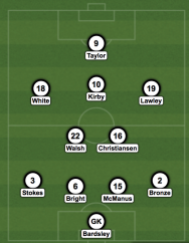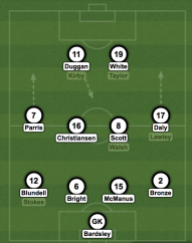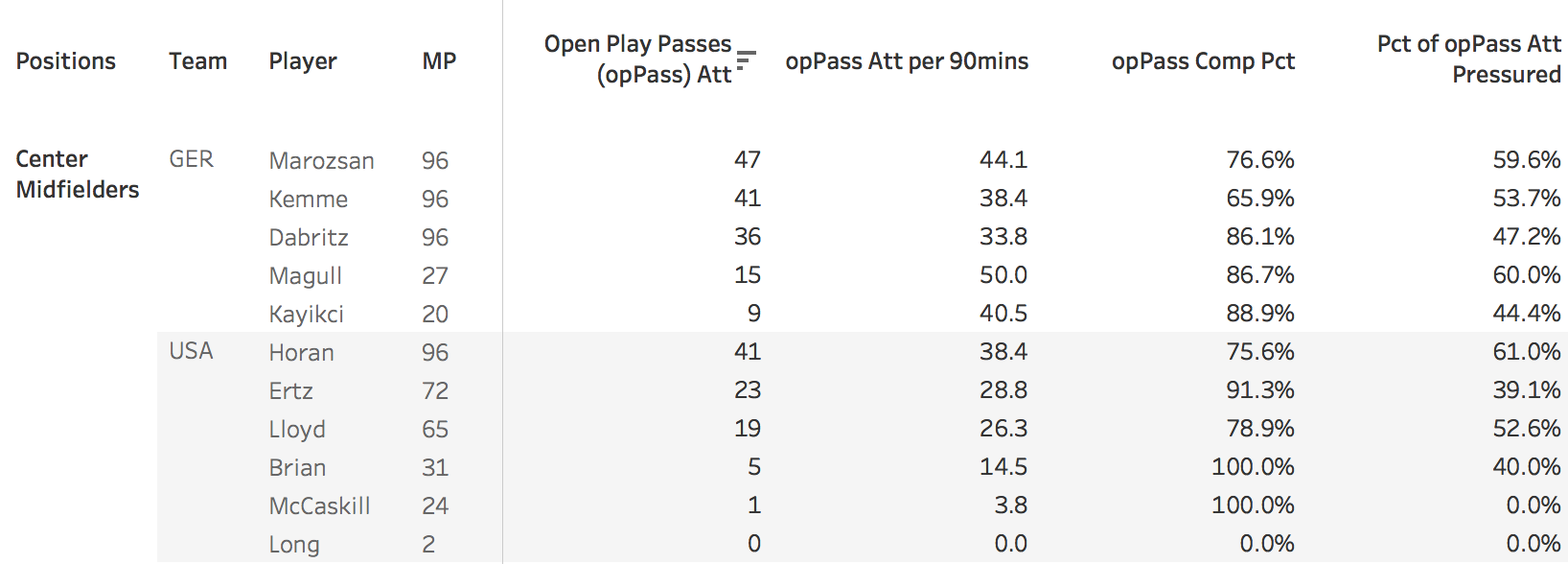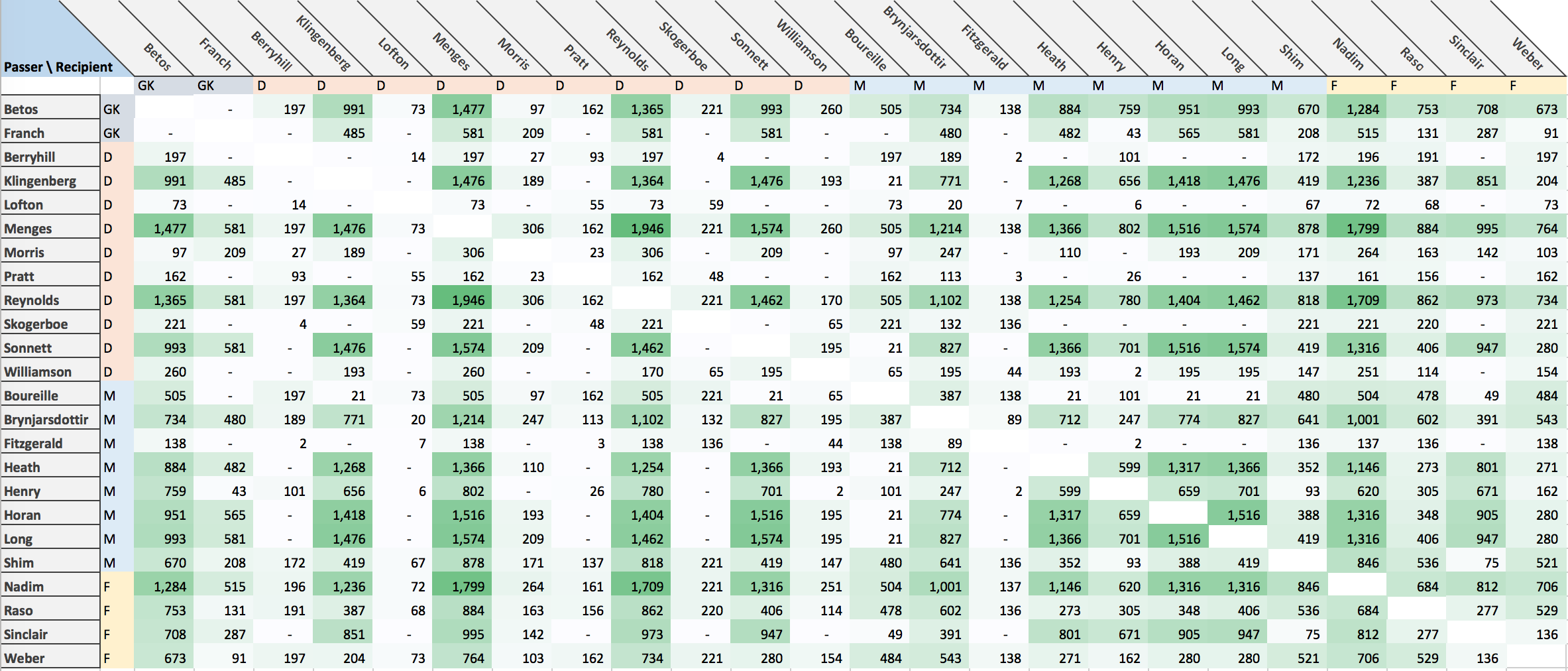Two weeks ago, I touched a bit on open play passing stats for Ali Krieger by breaking down attempts and completion percentage by thirds of the field. Since then, I challenged myself to see how much I could dig into passing stats to try to find some differences between two players who on the face of it look very similar – Morgan Brian and Sarah Killion. They’ve both played primarily as defensive midfielders, they both pass the ball a similar amount of times, and they have almost the same passing completion percentage.
The following data is also only for 40 out of 103 NWSL 2016 matches that we’ve logged with complete location data. To see the list of matches this data represents, see the database in the WoSo Stats Github and look for all the matches with “yes” in the “location.complete” column.
As you read through the post below, please consider that this data is only possible to hard work from fans like you who have been logging matches over the past year. The WoSo Stats project needs your help to log more stats and location data for the NWSL 2016 season, for USWNT matches, and beyond. The more data we get, the better we’ll be able understand the sport. If you’re interested in logging data for matches , read more here and email me at wosostats.team@gmail.com or send me a DM at @WoSoStats on Twitter. All the data logged with be publicly available on the WoSo Stats Github repo.
Getting the passing stats
If you’re not interested in the coding aspect of this or how to get this data yourself, feel free to skip ahead to the next section. All the data used is available to download from this Tableau visualization.
The instructions for how to use the creating-stats.R file are here in the WoSo Stats Github repo. If you’re familiar with R, first things first, source this R file and then run the getStatsInBulk function with the arguments shown below:
your_stats_list <- getStatsInBulk(competition.slug = “nwsl-2016”,location = “thirds”,location_complete=TRUE,section=”passing”)
This will take about a minute. Then run the mergeMatchList function with the following arguments to get the stats table as a data frame named “your_stats”:
your_stats <- mergeStatsList(stats_list = your_stats_list,add_per90 = TRUE,location = “thirds”,section=”passing”)
In there are columns for open play passes, which in the columns are called “opPass.” Open play passes are defined as all passes that aren’t one of the following – namely, dead ball plays:
- Throw-ins
- Corner kicks
- Goal kicks
- Free kicks
- Drop kicks or throws by the goalkeeper
A change from previous posts is the “section” argument. Instead of creating a massive stat table with all sorts of stats you may not be interested in, you can now just create a stats table for a specific type of stats (attacking, passing, possession, defense, goalkeeping). For this analysis, we’ll only need to look at passing stats, so we can just assign “passing” to the section argument.
The “your_stats” data frame is the stats table that is behind the Tableau visualization that has all the charts shown below. The Tableau viz was created with Tableau Public, and you should be able to download it yourself. For now, let’s have a look at the data.
Overall Passing Stats
For starters, let’s look at how Brian and Killion look if we just look at two very basic stats – open play passes attempted per 90 and open play passing completion percentage, sorted by total open play passes attempted per 90.

Both Brian and Killion have nearly the same stats. Brian has 52.1 open play passes attempted per 90 minutes with an 82.3% passing completion percentage. Killion has 53.3 open play passes attempted per 90 minutes with an 84.7% passing completion percentage.
There’s a lot that could be happening deeper underneath those stats, so let’s look at that bar chart, broken down by open play passes attempted per 90 for each third of the field (defensive, middle, and attacking). Here, we begin to see some differences in where Brian and Killion’s passes are happening, and some big similarities as well compared to the players around them.

Killion, per 90 minutes, attempts a couple more open play passes in the middle 3rd. Brian, meanwhile, per 90 minutes, has a few more open play passes in the attacking 3rd. Brian seems slightly more attacking-minded and Killion attempts more of her passes out of the midfield. Killion, quite simply, with the matches we have that have location data logged data, attempts more open play passes out of the middle 3rd of the field, per 90 minutes, than anyone else in the league.
Compared to almost every other played visible here, they pass the ball in open play out of the middle 3rd more times than anyone else except for Barnes, who is only ahead of Brian. They both have a very high percentage of their passes coming out of the midfield.
Now, what about the passing percentages? Below is a chart stacking, for each player, their open play passing completion percentages in each third of the field. Almost everyone’s passing completion percentage drops as they get closer to the opponent’s goal, so here relative differences are what’s interesting to look at.

Recall that Killion had more open play passes attempted out of the middle 3rd. Now we can see that she also has a significantly higher passing completion out of the middle 3rd, 85.7%, than Brian – and almost everyone else in this list of top-16 most open play passes attempted per 90, except for Little, who has an astonishing 90.1%, and Fletcher, with whom she’s tied.
Brian, on the other hand, has a significantly higher passing completion percentage out of the attacking 3rd, 77.5% and nearly 12 points higher than Killion – and also tied with Buczkowski for highest out of everyone visible here. Do the math against Brian’s 8.2 open play passes attempted per 90 out of the attacking 3rd, and she’s good for at least 6 completed passes in that third of the field for any given game.
We’ll break down these middle 3rd and attacking 3rd passes further by breaking them down in two different ways – by the direction of the pass (backwards, sideways, or forwards) and by how many were through balls, launch balls, or crosses. That’ll help us better understand what might be behind the differences in passing percentages and how they might differ in the types of passes they attempt.
Open Play Passes by Direction
Below are bar charts now for only Killion and Brian, showing the percentage of their open play pass attempts that went forward, sideways, and backwards, for each third of the field.

Brian and Killion have virtually the same distribution of open play passes by direction in the middle 3rd, so any differences we can glean from our stats aren’t quite going to be found here. Killion’s open play passing direction in the attacking 3rd, however, is massively different. 71% of her open play passing attempts in the attacking 3rd are going forward, compared to Brian’s 40%. It’s not clear yet, although it might be a smart guess, if these forward pass attempts are what’s bringing down her passing completion percentage. Also recall that this represents about 5.4 and 8.2 open play pass attempts per 90 in the attacking 3rd for Killion and Brian, respectively. Do the math and this means that, even with less attempts in the attacking 3rd, Killion comes out at about 3.8 forward open play pass attempts per 90 compared to Brian’s 3.3. It’s a difference of 1 more forward pass attempt every other game for Killion.
Numbers for attempts by direction are good and give insight into how Brian and Killion are trying to move the ball around but we also have data on passing completion percentages. Below are bar charts breaking down open play pass attempts by direction in the middle 3rd. Each pair of bar charts is for a different direction – backwards, sideways, and forward. The red is incomplete pass attempts, and the orange is complete pass attempts.

Recall that Killion had a couple more pass attempts per 90 in this third of the field, and a significantly higher passing completion percentage, but as far as distribution of direction of passes (the previous chart) they were both very similar. Now Killion and Brian have very similar numbers of pass completed per 90 minutes for backwards and sideways passes, but there’s a significant change for forward passes. Killion is good for almost 3 more completed forward passes in the middle third.
Now let’s look at this same chart, but for the attacking 3rd where there were big differences in the distribution of passes by direction and where Brian had a significantly higher passing completion percentage.

The differences in completed passes are barely above 1, but they do add up, especially considering the total number of pass attempts in this third of the field for both players are in the single digits. So that difference of 0.9 more forward pass incompletions per 90 isn’t massive, but it is chipping away at Killion’s passing completion percentage.
At this point it’s worth noting that the past few charts mean different things depending on how much a “forward pass completion,” a higher “passing completion percentage,” or more “pass attempts per 90” means to you. It intuitively seems to make sense that more of each is good, but with these two players they’ve each had higher numbers in different areas – no one appears to be significantly higher across all stats. Killion in the middle 3rd has a few more forward passes completed, a higher completion percentage, and more open play pass attempts per 90. Brian in the attacking 3rd, however, has slightly more forward passes completed, a higher completion percentage, and more open play pass attempts per 90. If you’re going to get into a discussion about which midfielder is “better” based on these stats, you also need to talk about what you expect out of a defensive midfielder. How good to you expect them to be at passing in the midfield, and – assuming attacking duties aren’t their primary responsibilities – how good do they have to be in the attacking 3rd to make up for a difference compared to someone else in the middle 3rd?
And then there’s the question of how much passing numbers should be adjusted given a team’s players, formation, tactics, and overall performance. If Killion’s passing numbers in the middle 3rd on the face of it are good enough, is there something about the way Brian’s team, the Houston Dash, plays and performs that may forgive lower numbers? The same goes for the attacking 3rd – Brian’s numbers look better, but is there something about Killion’s team, Sky Blue FC, that when taken into consideration makes her a more valuable player than Brian in the attacking 3rd? And, as far as this project is concerned, how much of this extra information is in all the data we’ve already tracked and can thus analyze ourselves?
Some of this additional information is likely sitting in all the match spreadsheets that have been logged for this WoSo Stats project – there’s the potential for further insights if we could get data on passing networks, on situations such as when a team is trailing, on matchups based on the type of players and teams a player is going up against, and likely much more.
For now, let’s look at two more types of passing data. We’ll look at completed passes that go across different thirds of the field, and special types of passes – launch balls, through balls, and crosses in the middle 3rd and attacking 3rd.
Passing Range
The chart below shows the top players by open play passes attempted per 90, with passes completed from the middle 3rd into different thirds of the field (and within the middle third) and with passes completed from the attacking 3rd back into the middle 3rd and within that attacking 3rd. We only have data for completed passes because sometimes it’s not reliably possible to figure out where an incomplete pass was trying to go – such as when it’s blocked right in front of a player trying to pass the ball and it’s not clear just how far down the field the ball was supposed to go.

Killion overall is completing more passes within and out of the midfield, close to 5 more. The great majority of those are passes that stay within the middle 3rd, and the same is true for Brian. Brian has a few more passes completed within the attacking 3rd. Overall, there doesn’t appear to be a whole lot here to differentiate the two. They’re both obviously distinct from a lot of other players visible here, but it looks like all we can tell from this is that Killion completes more passes per 90 minutes within the middle 3rd than Brian.
Through Balls, Launch Balls, and Crosses
Finally, a look at through balls and launch balls out of the middle 3rd, and through balls and crosses out of the attacking 3rd. Numbers for both players here per 90 minutes end up being small. In the red is incomplete open play pass attempts, and in the orange is complete open play pass attempts.


Killion in the middle 3rd appears better at launching the ball forward and completing a through pass, with more completions per 90 and a higher completion percentage for each type of pass.
There’s less to see in the attacking 3rd for either player. Killion and Brian barely complete any through balls from the attacking 3rd, likely because by the time they’re in the attacking 3rd from deep in the midfield most of the opposing team’s defense is already well situated in front of the goal. Killion attempts a negligible amount of crosses, and Brian completes about one cross every other game.
Next steps
These two players were an interesting case study because of how similar they are in playing style and how good they are. I had to explore quite a bit of stats as on the face of it they were quite similar with regards to passing attempts and completion percentage, even when broken down by thirds of the field.
In the future, I’d like to do this with other NWSL players who are also considered defensive midfielders – players like Buczkowski and Winters, and others – to see just how alike everyone who plays this type of midfielder role really is. I touched on this briefly, but something like a passing network visualized, showing just who is getting all these passes, could also shed light on not just where players like Killion and Brian distribute the ball, but who they’re passing it to. Are they passing it off to mostly defenders, wingers, attacking midfielders, or straight to the forwards? There’s also curious cases where each player has lined up not quite in the defensive midfielder role but maybe somewhere further up the midfield or outside the wing – it could be possible to account for those matches. And I haven’t even added any stats related to defending, which is a whole ‘nother aspect of being a defensive midfielder that is arguably just as important as how well they pass the ball.
This is all beyond the scope of this blog post, and I hope to revisit another time. Or feel free to go after it yourself, as the data is all there in the WoSo Stats GitHub repo. For now, I hope you’ve enjoyed a look at how the data we’ve logged can dig into the differences – and similarities – between two very good players who, with very few goals and assists, don’t show up prominently on traditional stats sheets based on goals and assists but, with the stats we’ve got, show up as vital parts of the midfield.
One last thing, and one last time, the WoSo Stats project needs your help! If you’re interested in logging data for matches , read more here and email me at wosostats.team@gmail.com or send me a DM at @WoSoStats on Twitter. All the data logged with be publicly available on the WoSo Stats Github repo.








































